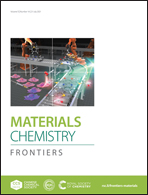Self-assembled nanoparticles formed via complementary nucleobase pair interactions between drugs and nanocarriers for highly efficient tumor-selective chemotherapy†
Abstract
We report a significant breakthrough in the development of complementary hydrogen-bonded drug-carrier systems, namely the construction of self-assembled nanoparticles with desirable functionalities conferred by the presence of stable complementary uracil–adenine (U–A) hydrogen bonding interactions between the drug and carrier complex. Herein, an adenine-functionalized rhodamine derivative (A-R6G) was successfully synthesized, and exhibited a variety of interesting physical properties including unique hydrophobicity, hydrogen bond-modulated green-fluorescence behavior and potent tumor-cell specific cytotoxicity. A-R6G strongly associates with uracil end-capped difunctional poly(propylene glycol) (BU-PPG) to spontaneously form spherical nanoparticles in aqueous solution due to the complementary U–A interactions between the drug and the carrier. These nanoparticles possess several interesting physical properties, such as ultrahigh drug loading content (up to 84.3%), a wide-range tunable drug loading ratio, high A-R6G-encapsulation stability in serum-rich culture media and pH/temperature-sensitive controlled drug release; these properties are very rare in drug-loaded nanoparticles, but are extremely desirable for drug-delivery applications based on polymeric micelles. Surprisingly, A-R6G-loaded nanoparticles exhibited selective cytotoxicity against cancer cells but had no effects on normal cells, whereas control rhodamine 6G-loaded nanoparticles displayed potent non-selective cytotoxicity, suggesting that the U–A interactions within the nanoparticles critically enhance the tumor-selective cytotoxicity of A-R6G towards cancer cells. Importantly, fluorescence imaging and flow cytometric assays confirmed that A-R6G-loaded nanoparticles were selectively delivered into cancer cells via an endocytic pathway and subsequently induced apoptotic cell death, but had minimal cytotoxic effects on normal cells. Thus, this complementary drug-carrier system has the ability to achieve targeted cancer chemotherapy with high therapeutic efficacy and safety.



 Please wait while we load your content...
Please wait while we load your content...